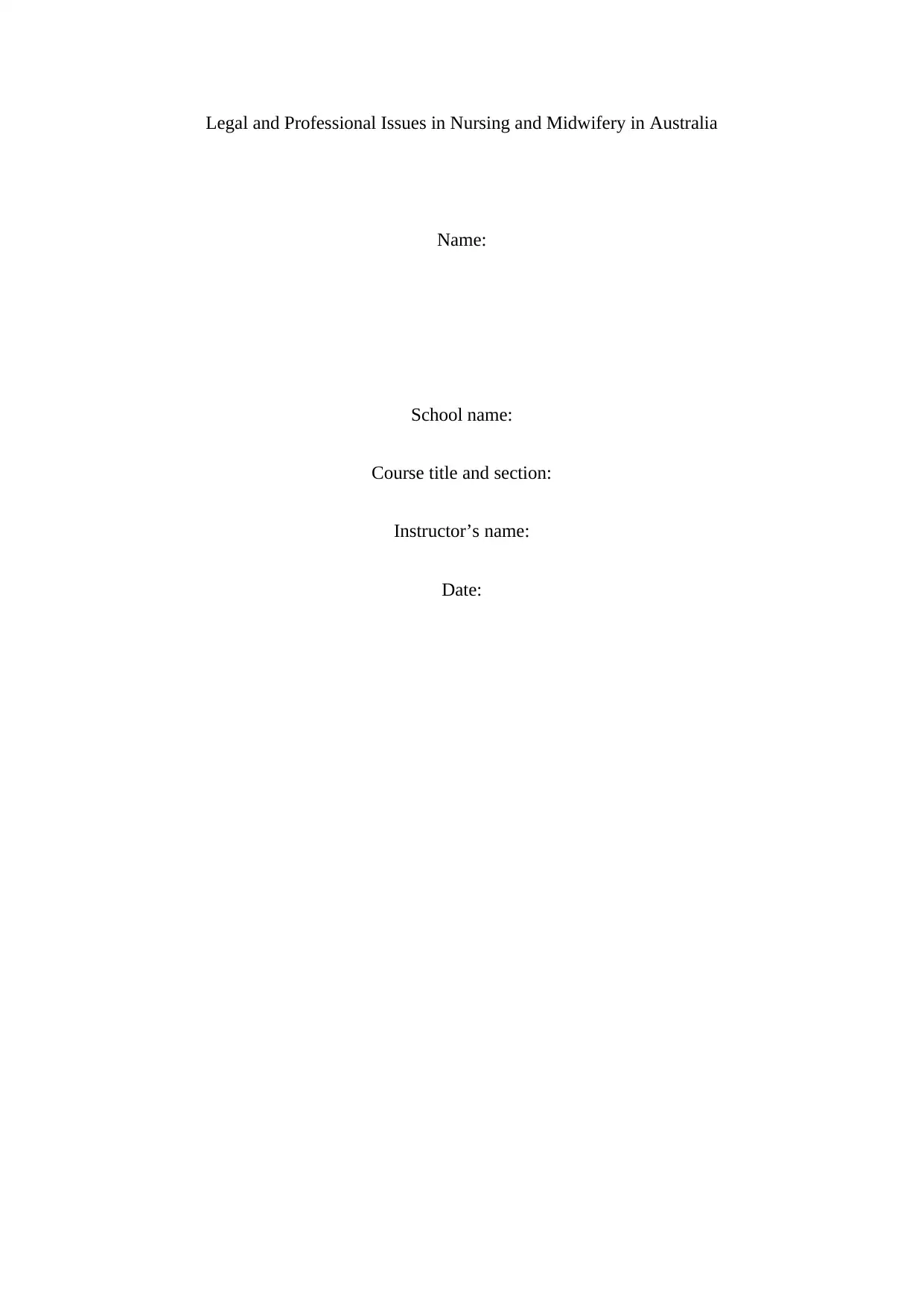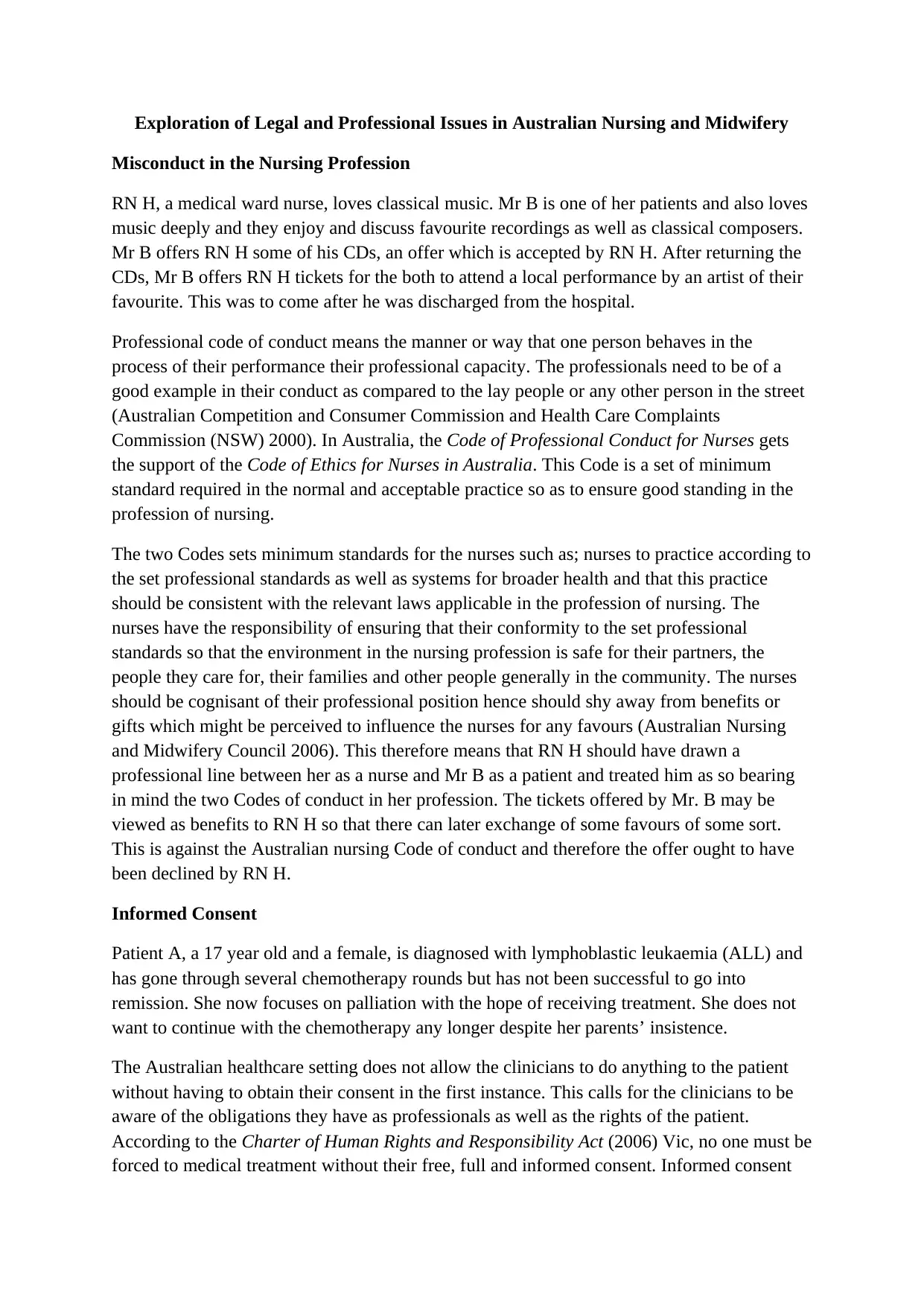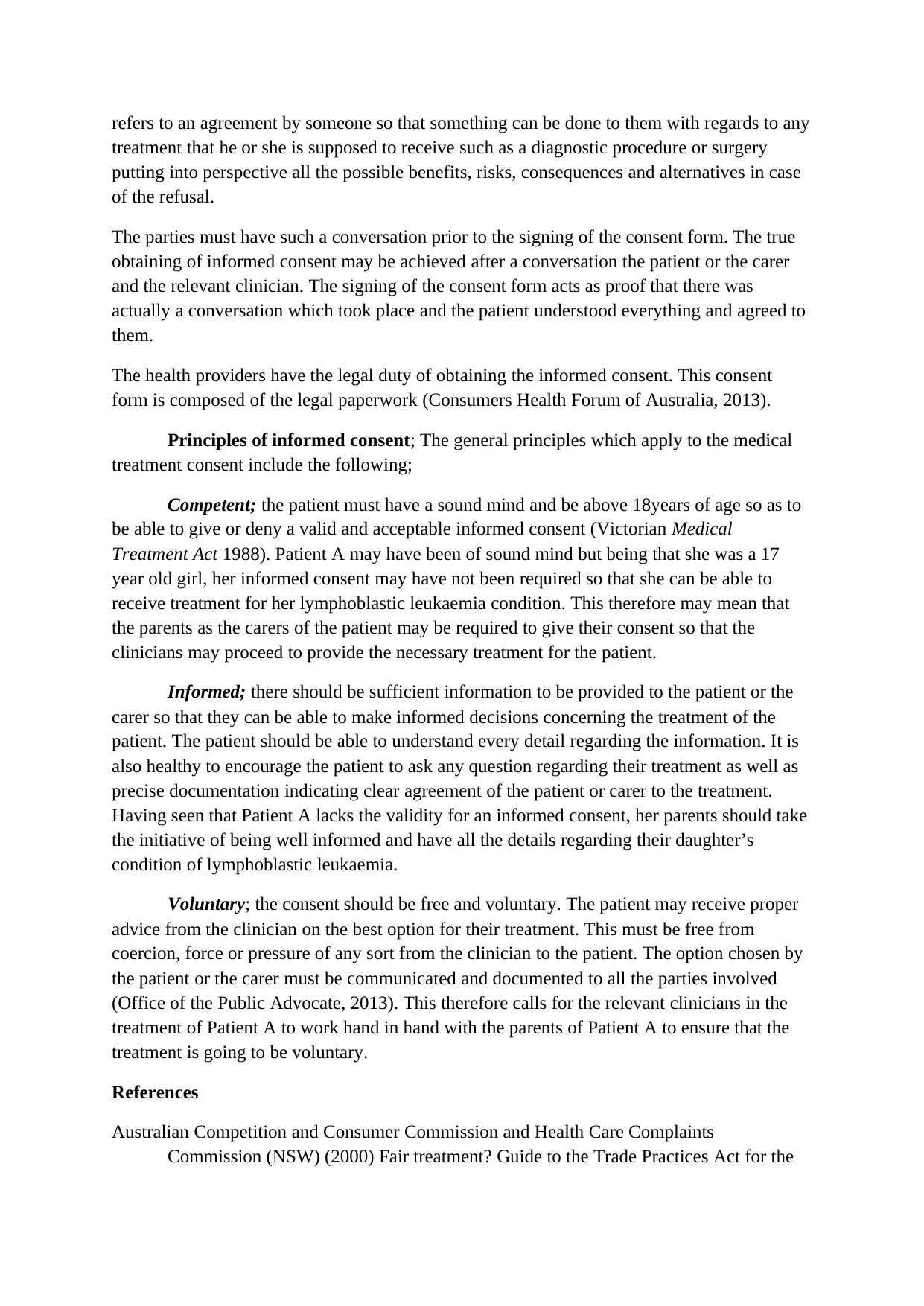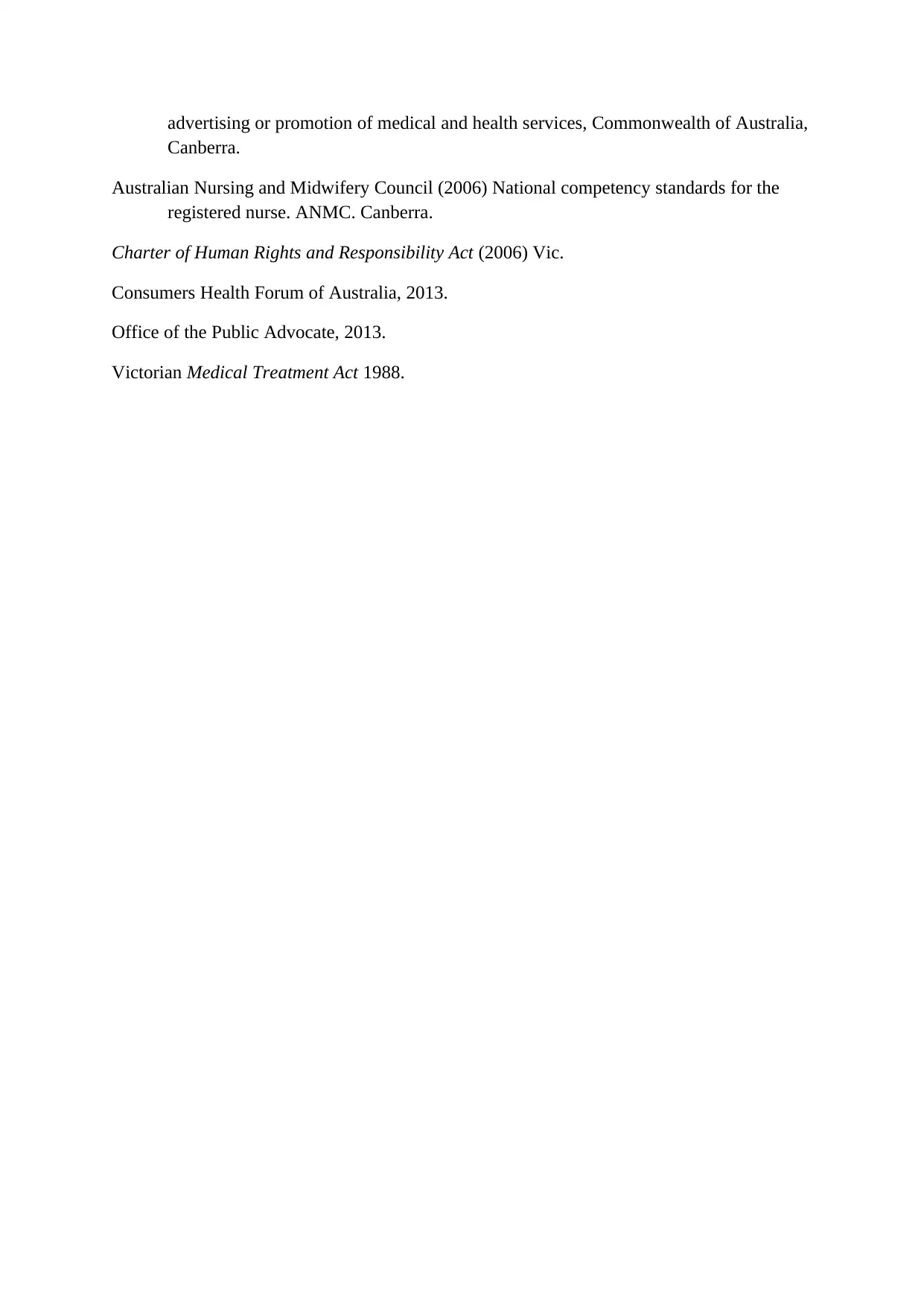Analysis of Legal and Professional Issues in Australian Nursing
VerifiedAdded on 2023/03/30
|4
|1119
|191
Report
AI Summary
This report analyzes key legal and professional issues within the Australian nursing and midwifery context. It explores scenarios related to nurse misconduct, such as accepting gifts from patients, and analyzes the ethical and legal implications based on the Code of Professional Conduct for Nurses and the Code of Ethics for Nurses in Australia. The report also examines informed consent, particularly in the case of a 17-year-old patient with lymphoblastic leukemia, considering the principles of competence, information, and voluntariness. It discusses the legal requirements for obtaining informed consent and the roles of parents or guardians when patients are minors. The report references relevant legislation and guidelines, including the Charter of Human Rights and Responsibility Act (2006) Vic and the Victorian Medical Treatment Act 1988, to provide a comprehensive overview of the legal and ethical considerations in nursing practice.

Legal and Professional Issues in Nursing and Midwifery in Australia
Name:
School name:
Course title and section:
Instructor’s name:
Date:
Name:
School name:
Course title and section:
Instructor’s name:
Date:
Paraphrase This Document
Need a fresh take? Get an instant paraphrase of this document with our AI Paraphraser

Exploration of Legal and Professional Issues in Australian Nursing and Midwifery
Misconduct in the Nursing Profession
RN H, a medical ward nurse, loves classical music. Mr B is one of her patients and also loves
music deeply and they enjoy and discuss favourite recordings as well as classical composers.
Mr B offers RN H some of his CDs, an offer which is accepted by RN H. After returning the
CDs, Mr B offers RN H tickets for the both to attend a local performance by an artist of their
favourite. This was to come after he was discharged from the hospital.
Professional code of conduct means the manner or way that one person behaves in the
process of their performance their professional capacity. The professionals need to be of a
good example in their conduct as compared to the lay people or any other person in the street
(Australian Competition and Consumer Commission and Health Care Complaints
Commission (NSW) 2000). In Australia, the Code of Professional Conduct for Nurses gets
the support of the Code of Ethics for Nurses in Australia. This Code is a set of minimum
standard required in the normal and acceptable practice so as to ensure good standing in the
profession of nursing.
The two Codes sets minimum standards for the nurses such as; nurses to practice according to
the set professional standards as well as systems for broader health and that this practice
should be consistent with the relevant laws applicable in the profession of nursing. The
nurses have the responsibility of ensuring that their conformity to the set professional
standards so that the environment in the nursing profession is safe for their partners, the
people they care for, their families and other people generally in the community. The nurses
should be cognisant of their professional position hence should shy away from benefits or
gifts which might be perceived to influence the nurses for any favours (Australian Nursing
and Midwifery Council 2006). This therefore means that RN H should have drawn a
professional line between her as a nurse and Mr B as a patient and treated him as so bearing
in mind the two Codes of conduct in her profession. The tickets offered by Mr. B may be
viewed as benefits to RN H so that there can later exchange of some favours of some sort.
This is against the Australian nursing Code of conduct and therefore the offer ought to have
been declined by RN H.
Informed Consent
Patient A, a 17 year old and a female, is diagnosed with lymphoblastic leukaemia (ALL) and
has gone through several chemotherapy rounds but has not been successful to go into
remission. She now focuses on palliation with the hope of receiving treatment. She does not
want to continue with the chemotherapy any longer despite her parents’ insistence.
The Australian healthcare setting does not allow the clinicians to do anything to the patient
without having to obtain their consent in the first instance. This calls for the clinicians to be
aware of the obligations they have as professionals as well as the rights of the patient.
According to the Charter of Human Rights and Responsibility Act (2006) Vic, no one must be
forced to medical treatment without their free, full and informed consent. Informed consent
Misconduct in the Nursing Profession
RN H, a medical ward nurse, loves classical music. Mr B is one of her patients and also loves
music deeply and they enjoy and discuss favourite recordings as well as classical composers.
Mr B offers RN H some of his CDs, an offer which is accepted by RN H. After returning the
CDs, Mr B offers RN H tickets for the both to attend a local performance by an artist of their
favourite. This was to come after he was discharged from the hospital.
Professional code of conduct means the manner or way that one person behaves in the
process of their performance their professional capacity. The professionals need to be of a
good example in their conduct as compared to the lay people or any other person in the street
(Australian Competition and Consumer Commission and Health Care Complaints
Commission (NSW) 2000). In Australia, the Code of Professional Conduct for Nurses gets
the support of the Code of Ethics for Nurses in Australia. This Code is a set of minimum
standard required in the normal and acceptable practice so as to ensure good standing in the
profession of nursing.
The two Codes sets minimum standards for the nurses such as; nurses to practice according to
the set professional standards as well as systems for broader health and that this practice
should be consistent with the relevant laws applicable in the profession of nursing. The
nurses have the responsibility of ensuring that their conformity to the set professional
standards so that the environment in the nursing profession is safe for their partners, the
people they care for, their families and other people generally in the community. The nurses
should be cognisant of their professional position hence should shy away from benefits or
gifts which might be perceived to influence the nurses for any favours (Australian Nursing
and Midwifery Council 2006). This therefore means that RN H should have drawn a
professional line between her as a nurse and Mr B as a patient and treated him as so bearing
in mind the two Codes of conduct in her profession. The tickets offered by Mr. B may be
viewed as benefits to RN H so that there can later exchange of some favours of some sort.
This is against the Australian nursing Code of conduct and therefore the offer ought to have
been declined by RN H.
Informed Consent
Patient A, a 17 year old and a female, is diagnosed with lymphoblastic leukaemia (ALL) and
has gone through several chemotherapy rounds but has not been successful to go into
remission. She now focuses on palliation with the hope of receiving treatment. She does not
want to continue with the chemotherapy any longer despite her parents’ insistence.
The Australian healthcare setting does not allow the clinicians to do anything to the patient
without having to obtain their consent in the first instance. This calls for the clinicians to be
aware of the obligations they have as professionals as well as the rights of the patient.
According to the Charter of Human Rights and Responsibility Act (2006) Vic, no one must be
forced to medical treatment without their free, full and informed consent. Informed consent

refers to an agreement by someone so that something can be done to them with regards to any
treatment that he or she is supposed to receive such as a diagnostic procedure or surgery
putting into perspective all the possible benefits, risks, consequences and alternatives in case
of the refusal.
The parties must have such a conversation prior to the signing of the consent form. The true
obtaining of informed consent may be achieved after a conversation the patient or the carer
and the relevant clinician. The signing of the consent form acts as proof that there was
actually a conversation which took place and the patient understood everything and agreed to
them.
The health providers have the legal duty of obtaining the informed consent. This consent
form is composed of the legal paperwork (Consumers Health Forum of Australia, 2013).
Principles of informed consent; The general principles which apply to the medical
treatment consent include the following;
Competent; the patient must have a sound mind and be above 18years of age so as to
be able to give or deny a valid and acceptable informed consent (Victorian Medical
Treatment Act 1988). Patient A may have been of sound mind but being that she was a 17
year old girl, her informed consent may have not been required so that she can be able to
receive treatment for her lymphoblastic leukaemia condition. This therefore may mean that
the parents as the carers of the patient may be required to give their consent so that the
clinicians may proceed to provide the necessary treatment for the patient.
Informed; there should be sufficient information to be provided to the patient or the
carer so that they can be able to make informed decisions concerning the treatment of the
patient. The patient should be able to understand every detail regarding the information. It is
also healthy to encourage the patient to ask any question regarding their treatment as well as
precise documentation indicating clear agreement of the patient or carer to the treatment.
Having seen that Patient A lacks the validity for an informed consent, her parents should take
the initiative of being well informed and have all the details regarding their daughter’s
condition of lymphoblastic leukaemia.
Voluntary; the consent should be free and voluntary. The patient may receive proper
advice from the clinician on the best option for their treatment. This must be free from
coercion, force or pressure of any sort from the clinician to the patient. The option chosen by
the patient or the carer must be communicated and documented to all the parties involved
(Office of the Public Advocate, 2013). This therefore calls for the relevant clinicians in the
treatment of Patient A to work hand in hand with the parents of Patient A to ensure that the
treatment is going to be voluntary.
References
Australian Competition and Consumer Commission and Health Care Complaints
Commission (NSW) (2000) Fair treatment? Guide to the Trade Practices Act for the
treatment that he or she is supposed to receive such as a diagnostic procedure or surgery
putting into perspective all the possible benefits, risks, consequences and alternatives in case
of the refusal.
The parties must have such a conversation prior to the signing of the consent form. The true
obtaining of informed consent may be achieved after a conversation the patient or the carer
and the relevant clinician. The signing of the consent form acts as proof that there was
actually a conversation which took place and the patient understood everything and agreed to
them.
The health providers have the legal duty of obtaining the informed consent. This consent
form is composed of the legal paperwork (Consumers Health Forum of Australia, 2013).
Principles of informed consent; The general principles which apply to the medical
treatment consent include the following;
Competent; the patient must have a sound mind and be above 18years of age so as to
be able to give or deny a valid and acceptable informed consent (Victorian Medical
Treatment Act 1988). Patient A may have been of sound mind but being that she was a 17
year old girl, her informed consent may have not been required so that she can be able to
receive treatment for her lymphoblastic leukaemia condition. This therefore may mean that
the parents as the carers of the patient may be required to give their consent so that the
clinicians may proceed to provide the necessary treatment for the patient.
Informed; there should be sufficient information to be provided to the patient or the
carer so that they can be able to make informed decisions concerning the treatment of the
patient. The patient should be able to understand every detail regarding the information. It is
also healthy to encourage the patient to ask any question regarding their treatment as well as
precise documentation indicating clear agreement of the patient or carer to the treatment.
Having seen that Patient A lacks the validity for an informed consent, her parents should take
the initiative of being well informed and have all the details regarding their daughter’s
condition of lymphoblastic leukaemia.
Voluntary; the consent should be free and voluntary. The patient may receive proper
advice from the clinician on the best option for their treatment. This must be free from
coercion, force or pressure of any sort from the clinician to the patient. The option chosen by
the patient or the carer must be communicated and documented to all the parties involved
(Office of the Public Advocate, 2013). This therefore calls for the relevant clinicians in the
treatment of Patient A to work hand in hand with the parents of Patient A to ensure that the
treatment is going to be voluntary.
References
Australian Competition and Consumer Commission and Health Care Complaints
Commission (NSW) (2000) Fair treatment? Guide to the Trade Practices Act for the
⊘ This is a preview!⊘
Do you want full access?
Subscribe today to unlock all pages.

Trusted by 1+ million students worldwide

advertising or promotion of medical and health services, Commonwealth of Australia,
Canberra.
Australian Nursing and Midwifery Council (2006) National competency standards for the
registered nurse. ANMC. Canberra.
Charter of Human Rights and Responsibility Act (2006) Vic.
Consumers Health Forum of Australia, 2013.
Office of the Public Advocate, 2013.
Victorian Medical Treatment Act 1988.
Canberra.
Australian Nursing and Midwifery Council (2006) National competency standards for the
registered nurse. ANMC. Canberra.
Charter of Human Rights and Responsibility Act (2006) Vic.
Consumers Health Forum of Australia, 2013.
Office of the Public Advocate, 2013.
Victorian Medical Treatment Act 1988.
1 out of 4
Related Documents
Your All-in-One AI-Powered Toolkit for Academic Success.
+13062052269
info@desklib.com
Available 24*7 on WhatsApp / Email
![[object Object]](/_next/static/media/star-bottom.7253800d.svg)
Unlock your academic potential
Copyright © 2020–2025 A2Z Services. All Rights Reserved. Developed and managed by ZUCOL.





